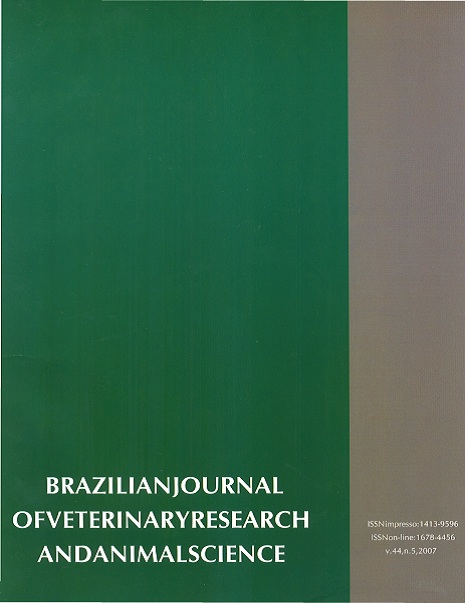Urolithiasis in the maned wolf (Chrysocyon brachyurus): Assessment of four clinical cases in captivity
DOI:
https://doi.org/10.11606/issn.1678-4456.bjvras.2007.26618Keywords:
Maned wolf, Urolithiasis, Mineral composition of uroliths, Clinical symptoms of urolithiasisAbstract
Four cases of urolithiasis in captive maned wolves (Chrysocyon brachyurus) were studied. All four animals were adult males. The clinical cases occurred in the period 1989-2004. The disease was manifested after 2 months to 10 years of captivity. The main clinical symptoms found were abdominal distension, recurrent urinary tract infections, pain upon abdominal palpation, difficulty urinating, polacyuria, hematuria, anorexia, dehydration, and urinary tenesmus evolving to anuria due to obstruction of the urethra by calculi. Radiological examination detected bladder distension and the presence of many radio-opaque uroliths in the bladder lumen. Diffraction analysis of uroliths showed they were made up of calcium acid pyrophosphate and basic hydrous manganese phosphate (n=1) and hydrous magnesium ammonium phosphate with traces of Potassium Calcium Phosphate (n=1). Electron microscopy showed that uroliths consisted of crystals with mineral phosphorus, potassium and magnesium (n=2) predominating in their composition. This is the first time any scientific research has demonstrated the occurrence of urolithiasis associated with uroliths of mineral composition based on phosphate, potassium and magnesium in captive maned wolves. The only cases of urolithiasis in maned wolves documented hitherto were cystine-related. Therapeutic measures for urolithiasis involve appropriate nutritional management, use of medication and, in some cases, specific surgical procedures. Diagnosis and treatment of the diseases to which wild animals are subject when in captivity are extremely important for maintenance and reproduction of these species with a view to their conservation in the environment.Downloads
Download data is not yet available.
Downloads
Published
2007-10-01
Issue
Section
UNDEFINIED
License
The journal content is authorized under the Creative Commons BY-NC-SA license (summary of the license: https://
How to Cite
1.
Fernandes LT de O, Marcolino M das GM. Urolithiasis in the maned wolf (Chrysocyon brachyurus): Assessment of four clinical cases in captivity. Braz. J. Vet. Res. Anim. Sci. [Internet]. 2007 Oct. 1 [cited 2024 Jul. 26];44(5):352-7. Available from: https://www.revistas.usp.br/bjvras/article/view/26618





